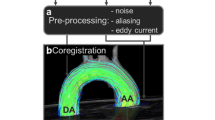Abstract
Objectives
To assess the diagnostic accuracy of phonocardiogram (PCG) gated velocity-encoded phase contrast magnetic resonance imaging (MRI).
Methods
Flow quantification above the aortic valve was performed in 68 patients by acquiring a retrospectively PCG- and a retrospectively ECG-gated velocity-encoded GE-sequence at 1.5 T. Peak velocity (PV), average velocity (AV), forward volume (FV), reverse volume (RV), net forward volume (NFV), as well as the regurgitant fraction (RF) were assessed for both datasets, as well as for the PCG-gated datasets after compensation for the PCG trigger delay.
Results
PCG-gated image acquisition was feasible in 64 patients, ECG-gated in all patients. PCG-gated flow quantification overestimated PV (Δ 3.8 ± 14.1 cm/s; P = 0.037) and underestimated FV (Δ -4.9 ± 15.7 ml; P = 0.015) and NFV (Δ -4.5 ± 16.5 ml; P = 0.033) compared with ECG-gated imaging. After compensation for the PCG trigger delay, differences were only observed for PV (Δ 3.8 ± 14.1 cm/s; P = 0.037). Wide limits of agreement between PCG- and ECG-gated flow quantification were observed for all variables (PV: -23.9 to 31.4 cm/s; AV: -4.5 to 3.9 cm/s; FV: -35.6 to 25.9 ml; RV: -8.0 to 7.2 ml; NFV: -36.8 to 27.8 ml; RF: -10.4 to 10.2 %).
Conclusions
The present study demonstrates that PCG gating in its current form is not reliable enough for flow quantification based on velocity-encoded phase contrast gradient echo (GE) sequences.
Key Points
• Phonocardiogram gating is an alternative to ECG-gating in cardiac MRI.
• Phonocardiogram gating shows only limited reliability for velocity-encoded cardiac MRI.
• Further refinements of the post-processing algorithm are necessary.







Similar content being viewed by others
References
Ladd ME (2007) High-field-strength magnetic resonance: potential and limits. Top Magn Reson Imaging 18:139–152
Kuhl CK, Traber F, Schild HH (2008) Whole-body high-field-strength (3.0-T) MR imaging in clinical practice. Part I. Technical considerations and clinical applications. Radiology 246:675–696
Schenck JF (2005) Physical interactions of static magnetic fields with living tissues. Prog Biophys Mol Biol 87:185–204
Frauenrath T, Hezel F, Renz W et al (2010) Acoustic cardiac triggering: a practical solution for synchronization and gating of cardiovascular magnetic resonance at 7 Tesla. J Cardiovasc Magn Reson 12:67
Frauenrath T, Hezel F, Heinrichs U et al (2009) Feasibility of cardiac gating free of interference with electro-magnetic fields at 1.5 Tesla, 3.0 Tesla and 7.0 Tesla using an MR-stethoscope. Invest Radiol 44:539–547
Becker M, Frauenrath T, Hezel F et al (2010) Comparison of left ventricular function assessment using phonocardiogram- and electrocardiogram-triggered 2D SSFP CINE MR imaging at 1.5 T and 3.0 T. Eur Radiol 20:1344–1355
Nassenstein K, Orzada S, Haering L et al (2012) Cardiac MRI: evaluation of phonocardiogram-gated cine imaging for the assessment of global und regional left ventricular function in clinical routine. Eur Radiol 22:559–568
Kramer CM, Barkhausen J, Flamm SD, Kim RJ, Nagel E (2008) Standardized cardiovascular magnetic resonance imaging (CMR) protocols, society for cardiovascular magnetic resonance: board of trustees task force on standardized protocols. J Cardiovasc Magn Reson 10:35
Hundley WG, Bluemke DA, Finn JP et al (2010) ACCF/ACR/AHA/NASCI/SCMR 2010 expert consensus document on cardiovascular magnetic resonance: a report of the American College of Cardiology Foundation Task Force on Expert Consensus Documents. Circulation 121:2462-2508
Bland JM, Altman DG (1986) Statistical methods for assessing agreement between two methods of clinical measurement. Lancet 1:307–310
Passing H, Bablok (1983) A new biometrical procedure for testing the equality of measurements from two different analytical methods. Application of linear regression procedures for method comparison studies in clinical chemistry, Part I. J Clin Chem Clin Biochem 21:709–720
Bilic-Zulle L (2011) Comparison of methods: Passing and Bablok regression. Biochem Med (Zagreb) 21:49–52
Cawley PJ, Maki JH, Otto CM (2009) Cardiovascular magnetic resonance imaging for valvular heart disease: technique and validation. Circulation 119:468–478
Author information
Authors and Affiliations
Corresponding author
Rights and permissions
About this article
Cite this article
Nassenstein, K., Orzada, S., Haering, L. et al. Cardiac magnetic resonance: is phonocardiogram gating reliable in velocity-encoded phase contrast imaging?. Eur Radiol 22, 2679–2687 (2012). https://doi.org/10.1007/s00330-012-2547-6
Received:
Revised:
Accepted:
Published:
Issue Date:
DOI: https://doi.org/10.1007/s00330-012-2547-6




